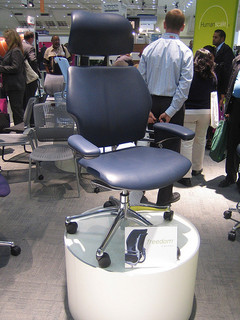
Although the office ‘task’ chair has been around in some form or another for over a century and a half, the design remained pretty much the same until the 1970’s. Around that time medical professionals joined forces with the leading manufacturers to create new designs that were not only functional but better for our long term health also. Ergonomics was the keyword of the seventies when it came to office chairs, and more and more designers and manufacturers jumped on the bandwagon. It is now commonly accepted by employers and employees alike that the type of chair they sit in must be able to support them correctly, and there are even government guidelines in place specifying the minimum ergonomic requirements for an office chair that is to be used for two or more hours per day. New technology and new materials mean the chair is changing rapidly.

1970’s
Ergonomics first became a word associated with office chairs in the seventies. New medical evidence had shown that many back problems were related to the issues that came from sitting down for long periods of time. In 1976, the very first ergonomic chair, The Ergon, was released into the marketplace. The Ergon was adjustable to allow it to fit the shape and size of the individual worker, while still retaining the features office chairs have had since their conception, such as a swivel seat and castors.
1980’s
In 1980, a new innovation in office chair engineering became available. German manufacturers Wilkhahn released the first of their FS-line swivel chairs – the first chair where a series of axes allowed the chair to follow the movements of the sitter, providing support no matter what work was being performed.
In 1984, the first major alternative to the classic chair shape came about. The renowned Norwegian manufacturer HAGs released the Capisco, the world’s first saddle chair. Saddle chairs are still popular today, as they promote active sitting and force the worker to keep core muscles moving slightly rather than allowing them to stiffen and have pressure build up.
1990’s
The nineties saw the birth of two of the most iconic chairs in ergonomic office chair history – The Aeron and the Freedom Chair. Herman Miller’s Aeron is still today seen as a badge of style and comfort, with its revolutionary mesh back, curved lumbar support and range of adjustable features. The Freedom Chair by Humanscale was self-adjusting, with a distinctive style that could be recognised anywhere.
2000 – Present
Over the past decade or so, most of the new advances in chair design have been related to creating a chair that does more than you would expect. With ergonomic design sorted, it was now time to get more for your money. The Embody, another Herman Miller creation, claimed to not only prevent health problems, but to actually heal you while you worked. Whether or not this is true remains to be seen, but the chair has been in use now for around four years so we should see some results soon.

In 2010, who else but Herman Miller released the first true eco-chair – the SAYL. This chair does everything you would expect, but reduces your carbon footprint at the same time. It has fewer parts and uses less material than a conventional chair, with a support structure based on that of suspension bridges.


This post was written on behalf of www.chairoffice.co.uk.
Image attribution 1|2|3|4|5










Comments